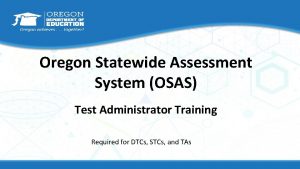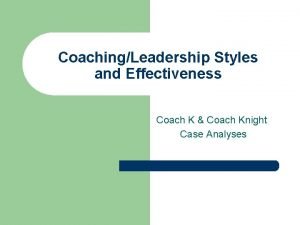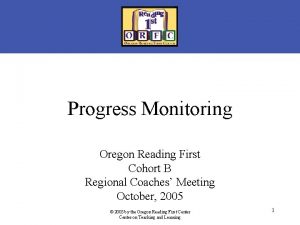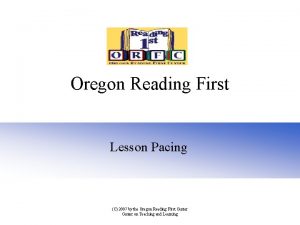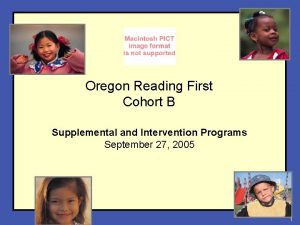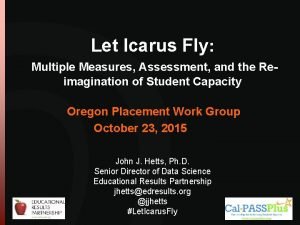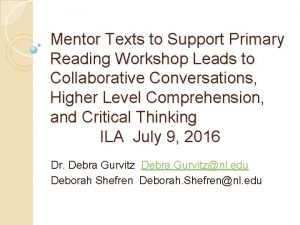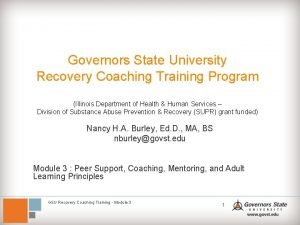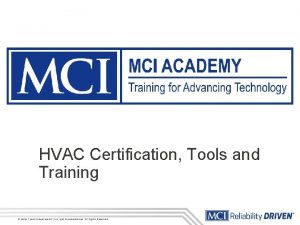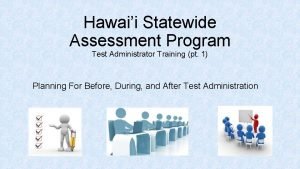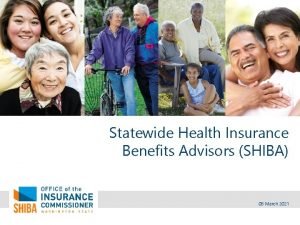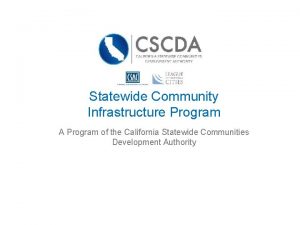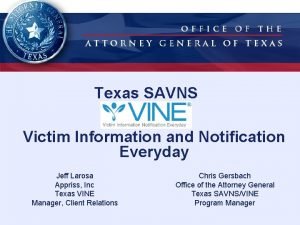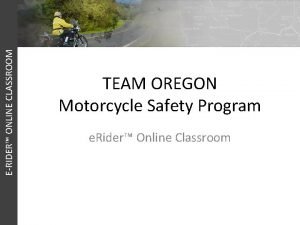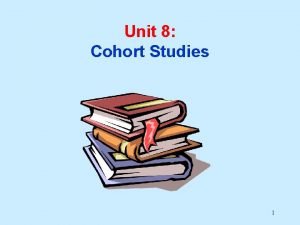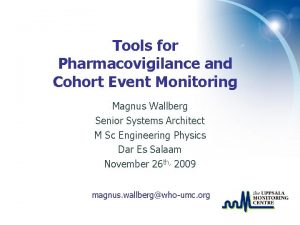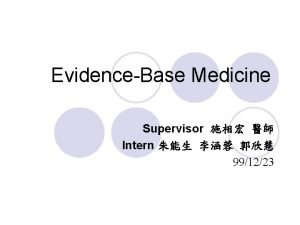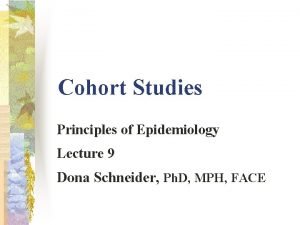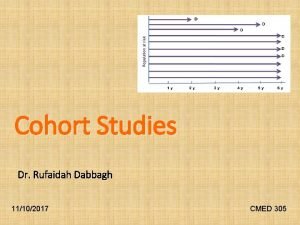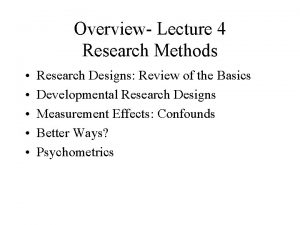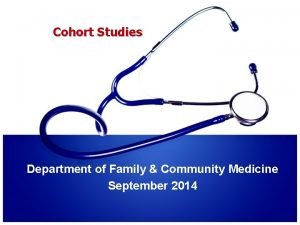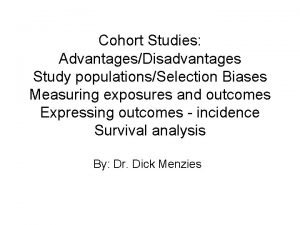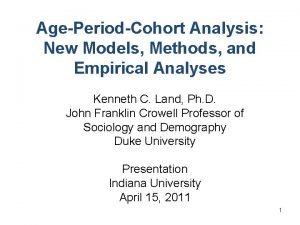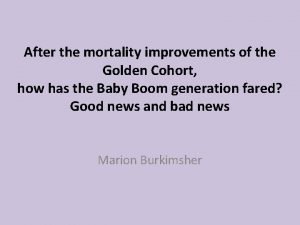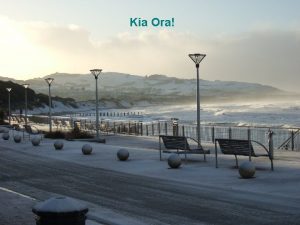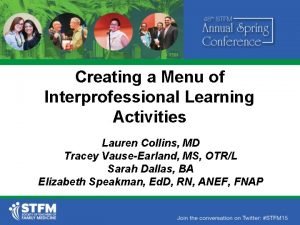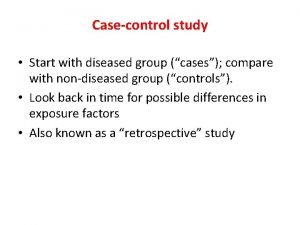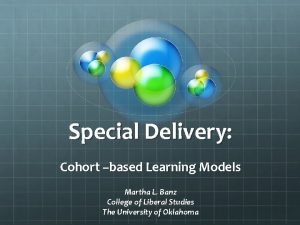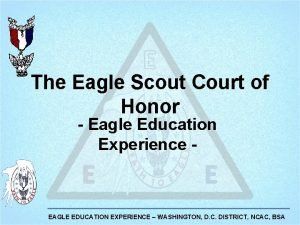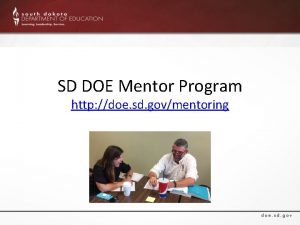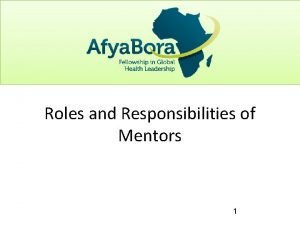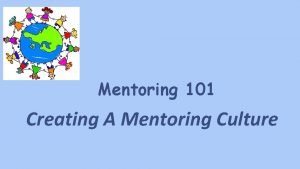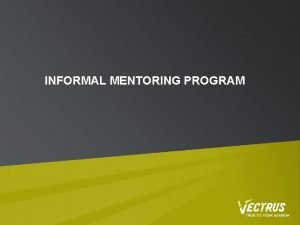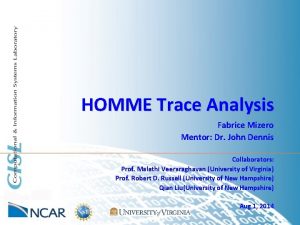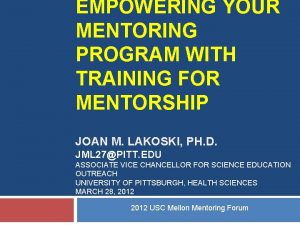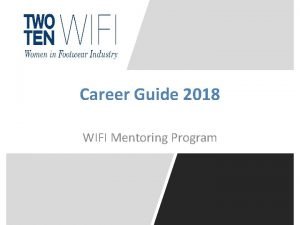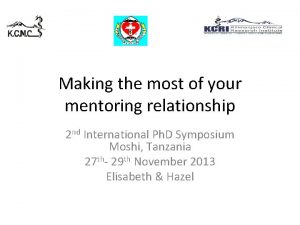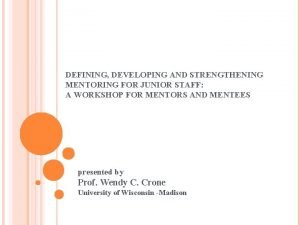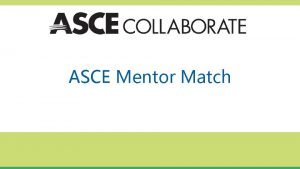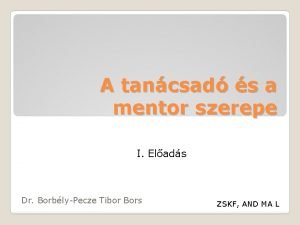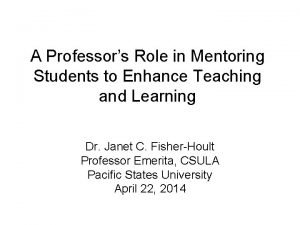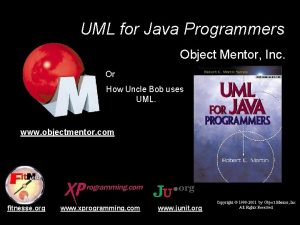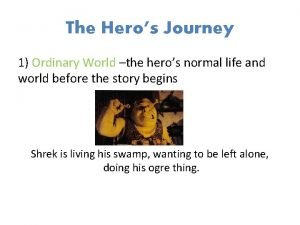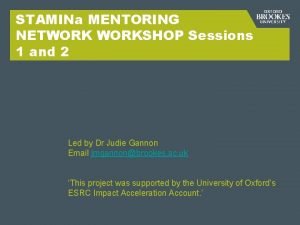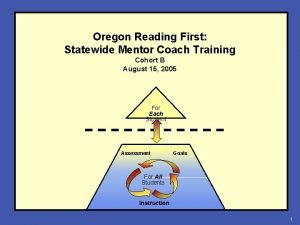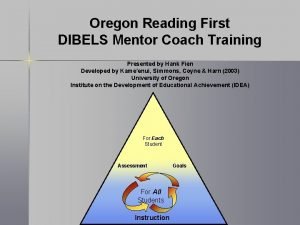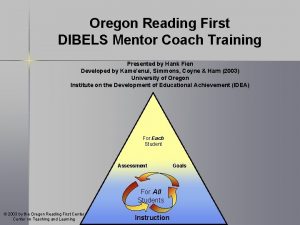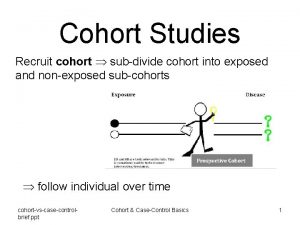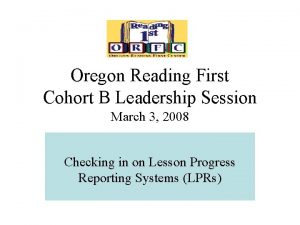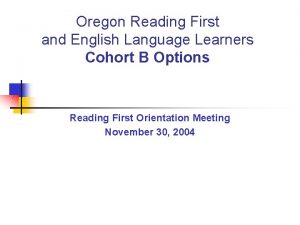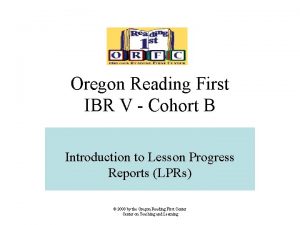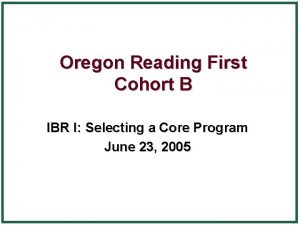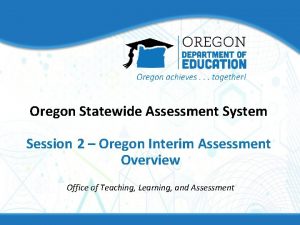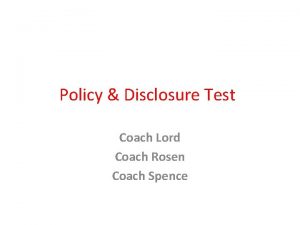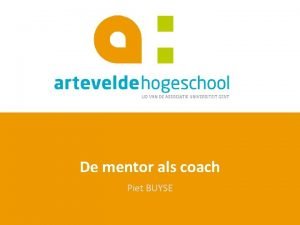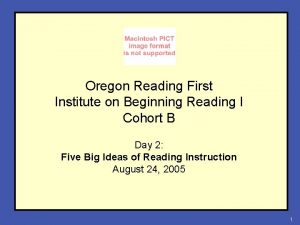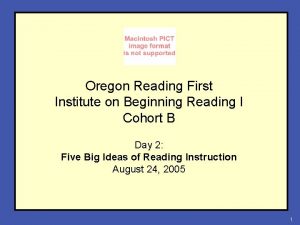Oregon Reading First Statewide Mentor Coach Training Cohort
















































































- Slides: 80

Oregon Reading First: Statewide Mentor Coach Training Cohort A Coaches September 9, 2005 For Each Student Assessment Goals For All Students Instruction © 2005 by the Oregon Reading First Center on Teaching and Learning


Welcome!!!! Opening Activity and Introductions

State-Level Reading First Oregon Department of Education Joni Gilles, Director Russ Sweet, Team Leader Oregon Reading First Center University of Oregon Scott Baker (B-ELL) Co-Director Carrie Thomas Beck (Cohort B) Co-Director Trish Travers Coordinator, Cohort A Hank Fien Coordinator of Evaluation B-ELL Support Team Doris Baker Judith Plasencia-Peinado Lupina Vela Wayne Callender Jeanie Smith Jennifer Walt Rachell Katz B-ELL Carol Dissen Pat Nash 4

Cohort A Regional Coordinator Assignments Trish Travers Carol Dissen Jennifer Walt Jeanie Smith Wayne Callender Beaverton Hillsboro David Douglas Jefferson County Portland (OC Schools) North Clackamas Milton. Freewater Portland (HM Schools) Ontario Rachell Katz Salem Pat Nash Coquille Albany Klamath Medford South Umpqua

RC Contact Information Trish Travers ttravers@uoregon. edu 541 -346 -3351 Carol Dissen cdissen@uoregon. edu 503 -640 -5585 Jennifer Walt jjwalt@uoregon. edu 208 -938 -5635 Jeanie Smith jmercier@uoregon. edu 541 -346 -2875 Wayne Callender TBA Rachell Katz rkatz@uoregon. edu 503 -274 -4828 Pat Nash pnash@uoregon. edu 541 -347 -2119

Year 03 Coaches’ Training

Region 1 Douglas County Green B J. Smith Winchester B J. Smith David Hill A C. Dissen Mooberry A C. Dissen W. L. Henry A C. Dissen Buff B J. Smith Madras B J. Smith Warm Springs A J. Smith Westside A J. Smith Lincoln County Arcadia B J. Smith N. Clackamas Lot Whitcomb A C. Dissen PPS Beach A C. Dissen Boise Eliot A C. Dissen Lent A C. Dissen Scott A C. Dissen Woodlawn A C. Dissen Hillsboro Jefferson County Sheridan Faulconer-Chapman B J. Smith

Region 2 Beaverton Aloha Park A T. Travers William Walker A T. Travers Forest Grove Fern Hill B-ELL D. Baker Hillsboro Witch Hazel B-ELL R. Katz Salem Hallman B R. Katz Hayesville A R. Katz Washington A R. Katz Liberty B-ELL R/ Katz Tillamook

Region 3 David Douglas Cherry Park A J. Walt Lincoln Park A J. Walt Mill Park A J. Walt Ventura Park A J. Walt West Powellhurst A J. Walt Earl Boyles B J. Walt Milton Freewater Grove/Freewater A J. Walt Ontario Alameda A J. Walt May Roberts A J. Walt Humboldt A W. Callender Whitman A W. Callender Jason Lee B W. Callender MLK Jr. B W. Callender Marysville B W. Callender Rigler B-ELL W. Callender Reynolds Margaret Scott B W. Callender Umatilla Mc. Nary Heights B-ELL W. Callender PPS

Region 4 Albany Sunrise A P. Nash Coquille Lincoln A P. Nash Klamath Chiloquin A P. Nash Medford Howard A P. Nash Jackson A P. Nash Jefferson A P. Nash Oak Grove A P. Nash Myrtle Creek A P. Nash Tri City A P. Nash South Umpqua












Web-Based Lesson Progress Reporting (LPR) Updates All Cohort A coaches (even those not currently using the web-based LPR) will participate in the V-Tel on September 19, 1: 00 -2: 30. Here are just a few exciting updates: n Coaches can access and update their teaching roster (August 31 email from Jon Hayes) n Menu bar for easier navigation with links on the left of the screen n Data can be sorted by column header n The layout of the data tables will grow with the size of the window for easier viewing n Students can be added to groups within classrooms, across classrooms, and across grades n LPRs can be viewed for specific groups.

Reading Assignment for November 4 Coaches’ Leadership Session Read Chapters 1, 3, 4, 5 and the Planning Guide on pages 159 -178 in The Reading Coach: A How-To Manual for Success by Jan Hasbrouck and Carolyn Denton

Observation System Veteran Cohort A Coaches

The “fidelity observation” feeling of the past. . . is being replaced with a retooled format to help you cut a clear path through the “fidelity observation jungle”!!

Observation Summary: Fall 2005 • • • One round of Five. Minute Observations of K-3 classroom teachers (+ follow up). Formal Fidelity Observations (+ follow up). One round of Five. Minute Observations of certified and classified specialists (+ follow up).

Observation Summary: Winter 2006 • Alternate Observation (+ follow up) **Note: December Regional Coaches meeting will provide information and training on alternate observation process and plans.

Observation Summary: Spring 2006 • • Alternate Observation (+ follow up). Coach must conduct Five -Minute Observations for grade level teachers not covered in the alternate observation plans.

Formal Fidelity Observation Parameters n n Who to Observe: ALL K-3 Classroom Teachers Length of Observation: The ENTIRE reading block

Organizing Principles for Observations 1. Observations will have a student focus as determined by grade level data. The observations will begin with all classroom teachers as a hub and then follow students to other groups.

Organizing Principles for Observations 2. 3. The entire reading block will be observed. Observations will document reading instruction across multiple programs and/or instructors.

Organizing Principles for Observations 4. If teachers are using only parts of a program (as might be the case with program specific templates) coaches will indicate the skipped activities on one line of the program fidelity checklist.

Organizing Principles for Observations 5. For items that are embedded in the reading block (a block longer than 90 minutes), such as language arts or writing, coaches will discuss with their regional coordinator how to document such activities.

Gathering of Information to Determine Coaching Support n n n Survey of Teacher Needs Summary of Teacher Needs 5 Minute Observation Summary Fidelity Observations

Survey of Teacher Needs n n n All teachers complete the Survey. Most of the headings are tied to the Big 5 Essential Reading Skills or to the General Features of Instruction as listed on the Fidelity Observation. Survey should be completed individually -- NOT as a group activity.

Summary of Teacher Needs n n Coach fills out the Summary for EACH grade level. Total and Average the scores for each column. Highlight areas of needed support for each teacher. The Coach will have a Summary of Teacher Needs for each grade level.

Five-Minute Observations The “snapshots” of instruction!

Five-Minute Observations n Headings tied to the “General Features of Instruction” from the Fidelity Observation Walk-Through

Five-Minute Observation Summary n n n Coach fills out the Summary for EACH grade level. Total the scores for each column. Highlight areas of needed support for each teacher.

Fidelity Observations n Rating System Changes: n N, P, F and E n Merged P/P+ to ONLY be “P” (partial) n Added “E” for Enhanced

Fidelity Observation n Enhancement Clarifications n Use an “E” when a teacher has made a worthwhile modification or has replaced an activity with one more valuable for their students (describe briefly in the comment box). n Use an “E” to rate an activity that the teacher added. This activity would be included at the end of the observation (describe briefly in the comment box). n If a teacher modifies the lesson with an activity that isn’t particularly strong, they would be expected to give that activity a “P” and make a note in the comments that the enhancement didn’t better the lesson (describe briefly in the comment box).

Fidelity Observations BIG IDEA for coaches: SPECIFICITY **Note: More time will be spent training on the Fidelity Observations at your October Regional Coaches Meeting.

Fidelity Observations n Brief and specific comments n n n n “modeling was explicit -- more repetitions may be helpful” “good think aloud” “teacher provided lots of examples” “many segmenting models” “high level of engagement” “great outcomes” “constant and immediate feedback”

Fidelity Observations n n Fill out ALL parts of a lesson on the Observation form. General Features of Instruction n n Be brief and specific. Use the Five-Minute Observation Form for comment ideas.

Fidelity Observation n n Areas Implemented Well n Be brief and specific. Identified Area(s) for Student Support n Choose a critical area and be brief! Action Plan n Needs to be connected to the Identified Area for Student Support and needs to be “doable”. Follow-Up Date n Be specific (2 weeks, 1 month, 4 th week of January, etc. )

Coaching Plan Use information from these areas we’ve discussed today to prioritize the needs in your building: n 1. 2. 3. Teacher Needs Summary Observations Student Assessments **We will be working further in this area with Carolyn Denton on November 4 th using her book, The Reading Coach: A How-To Manual for Success.

Professional Development and S-I Applications n n appropriate PD/S-I requests action plan implications for PD/S-I applications ordering new materials for curricula already in the building ordering new materials for previously-approved curricula already in the building n n send RC a list of materials to be ordered, a budget, and the date of the original S-I application However, if you will be using previously-approved curricula with a new population in your building, submit a new S-I application

CSI Maps • Discussion of questions/concerns about CSI maps • Study of sample CSI maps

Analyzing Data and Building Instructional Groups

Houghton Mifflin Assessments n Emerging Literacy Survey (K-2) n Houghton Mifflin Phonics/Decoding Screening Test (1 -6) n Houghton Mifflin Leveled Passages Assessment Kit (K-6) n Baseline Group Test (1 -6) n Integrated Theme Tests (K-6) n Theme Skills Tests (K-6) n Benchmark Progress Tests (1 -6) n Selection Tests (1 -6)

Integrated Assessment/ Intervention/Feedback Loop Teachers administer specific skills assessments Plan/implement Identify Need Validate Need Plan/Implement Instructional Support Evaluate Instructional Support Review Outcomes

Integrated Assessment/ Intervention/Feedback Loop Role of Teachers and Support Staff Role of Instructional Leadership § § § Analyze data and build instructional groups based on needs Take inventory and recommend materials needed for instruction Investigate and problem solve scheduling/spacing issues Investigate personnel resources with grade-level teams § § § View data and plan for meeting students’ needs Make decisions regarding the purchase of materials Make decisions regarding scheduling of staff Allocate personnel resources based on identified needs Set up systems of communication between all involved staff Articulate with everyone involved how needs are to be met

Kindergarten Benchmark Students

Kindergarten Strategic Students

Kindergarten Intensive Students

Grade 1 Benchmark Students

Grade 1 Strategic Students

Grade 1 Intensive Students

Grades 2 Benchmark Students

Grade 2 Strategic Students

Grade 2 Intensive Students

Grades 3 Benchmark Students

Grade 3 Strategic Students

Grade 3 Intensive Students

Critical Order Role of Teachers and Support Staff § § Analyze data and build instructional groups based on needs Take inventory and recommend materials needed for instruction Investigate and problem solve scheduling/spacing issues Investigate personnel resources with grade-level teams

Activity: Analyzing Data and Building Instructional Focus Groups n n 1. 2. 3. Read the Directions View the Sample Second Grade Assessment Data Place students in Instructional Focus 1. Place students in Instructional Focus 2 and note next to their name the topics that need to be retaught. Place students in Instructional Focus 3.

Activity Continued. . . 4. Place students in Instructional Focus 4. 5. Place students in Instructional Focus 5. Find the greatest area of need and place the student’s name in that box. Next to their name indicate the letter name/sounds that need to be reviewed or taught. 6. Place students in the ELD Instructional Focus box if they are English-language learners and require daily ELD instruction.

Discussion Activity When will you do this data analysis activity with your staff (think about the entire year)? ___________________________________ __________________ 1.

Discussion Activity 2. Who will be involved in this process? ___________________________________ __________________

Discussion Activity 3. What support does your staff need in order to have the necessary assessments complete? ___________________________________ __________________

Discussion Activity 4. How can you involve your school and district leadership in this process? ___________________________________ __________________

Sharing and Questions

Commonalities of GLTs and ERTs n n n Meet a minimum of once a month Discuss assessment data Evaluate instructional groups and make adjustments where necessary Refine/coordinate instructional programs at the student level Focus on whole grade level

Comparing GLTs and ERTs GLT Membership (including coach) n All teachers at a grade level n Specialists as needed n Principal as needed Instruction coordination at grade level Professional Development Review previous PD n Identify PD needs based on LPRs/in-program tests n PD on S-I programs Differentiated Instruction Focus Assessment ERT Teacher reps from K-3 n Building and district specialists n Principal n coordination across 1) grade levels 2)specialist and teachers n n Identify PD needs across grade levels Instructional Groups n Curriculum Building Schedules n Instructional Groups n Curriculum Patterns within and across students in a grade level Patterns within and across students and grades n n

ERT Responsibilities n n n Assessment *review assessment results *identify individual students who may need additional support Instruction *curriculum *instructional grouping/scheduling *coordinate instructional planning across grades *coordinate instructional planning across specialists Professional Development

ERT Agenda Items Group Brainstorming

n n n District RF Teams Meet at least four times in Year 3 Purposes include: *reviewing student data by school *communicating progress with stake holders *collaboration within and across cohorts *problem solving *building capacity district wide *building/sharing expertise Team members include: *district team leader *district team members *principals from RF schools *mentor coaches from RF schools

DRFT Agenda Items Group Brainstorming n September n November n February n June

Safe Travels Home!
 Retrospective cohort study vs prospective cohort study
Retrospective cohort study vs prospective cohort study Osas test administrator
Osas test administrator Coach k leadership style
Coach k leadership style Oregon reading first
Oregon reading first Oregon reading first
Oregon reading first Oregon reading first
Oregon reading first Icarus first cohort
Icarus first cohort Swbst format
Swbst format Mentor texts for reading workshop
Mentor texts for reading workshop Pre reading while reading and post reading activities
Pre reading while reading and post reading activities Recovery coach training illinois
Recovery coach training illinois Motor coach training
Motor coach training Training tot coach
Training tot coach Sba testing hawaii
Sba testing hawaii Nova payee services
Nova payee services Statewide health insurance benefits advisors
Statewide health insurance benefits advisors New york statewide senior action council
New york statewide senior action council Statewide community infrastructure program
Statewide community infrastructure program Michigan state industries
Michigan state industries Savns
Savns Statewide construction and development
Statewide construction and development Statewide benefits
Statewide benefits Statewide automated victim information notification
Statewide automated victim information notification Arizona statewide independent living council
Arizona statewide independent living council Erider team oregon
Erider team oregon Erider oregon
Erider oregon Cohort study example
Cohort study example What is a cohort study
What is a cohort study Magnus
Magnus What is case series
What is case series Language comprehension in psycholinguistics
Language comprehension in psycholinguistics Retrospective cohort vs case series
Retrospective cohort vs case series Retrospective cohort study vs case control
Retrospective cohort study vs case control Retrospective cohort study vs case control
Retrospective cohort study vs case control Types of cohort studies
Types of cohort studies Retrospective cohort study
Retrospective cohort study Jinyun yan
Jinyun yan Summary lean startup
Summary lean startup Demographic cohort
Demographic cohort Sequential research design
Sequential research design Cohort model
Cohort model Pregnancy and infant cohort monitoring and evaluation
Pregnancy and infant cohort monitoring and evaluation Cohort study community medicine
Cohort study community medicine Biases in cohort studies
Biases in cohort studies Cohort effects definition
Cohort effects definition Cohort effects definition
Cohort effects definition Golden cohort
Golden cohort Cohort event monitoring
Cohort event monitoring Students cohort
Students cohort Difference between case control and cohort study
Difference between case control and cohort study Difference between case control and cohort study
Difference between case control and cohort study Cohort adalah
Cohort adalah Cohort study definition
Cohort study definition Cohort based courses
Cohort based courses Kritik jurnal
Kritik jurnal Eagle scout mentor pin script
Eagle scout mentor pin script Sd doe mentoring
Sd doe mentoring Mentor responsibilities
Mentor responsibilities Mentor responsibilities
Mentor responsibilities Mentoring session agenda
Mentoring session agenda Mentor versus sponsor
Mentor versus sponsor Thank you letter mentor
Thank you letter mentor Mentor homme
Mentor homme Mulan the hero's journey
Mulan the hero's journey Mentor responsibilities
Mentor responsibilities Wise old mentor archetype
Wise old mentor archetype Mentor and mentee roles and responsibilities
Mentor and mentee roles and responsibilities Innate wisdom vs. educated stupidity
Innate wisdom vs. educated stupidity Greek gods archetypes
Greek gods archetypes Hmm spark
Hmm spark Romeo and juliet jeopardy
Romeo and juliet jeopardy What is a mentor sentence
What is a mentor sentence What does a mentor do
What does a mentor do Junior staff mentoring
Junior staff mentoring Asce mentor match
Asce mentor match Sa mentor
Sa mentor What does a mentor do
What does a mentor do Mentor pupil relationship archetype examples
Mentor pupil relationship archetype examples Uml for java programmers
Uml for java programmers Shrek tests allies and enemies
Shrek tests allies and enemies Stamina mentor
Stamina mentor

